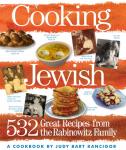
BUY COOKING JEWISH by clicking here now.
Something old and something new for the holiday
By JUDY BART KANCIGOR
The Orange County Register
September 17, 2009
RECIPES:
Chicken Casserole with Dried Fruit on a Bed of Couscous
Apple, Cinnamon and Walnut Cake
An old saying goes, ask two Jews a question and you'll get three opinions.
Controversy, controversy. In politics you expect it, but it's true even in
cooking.
Take the much maligned, yet oh, so beloved Jewish appetizer that graces
every holiday table from the weekly celebration of the Sabbath to Rosh Hashana,
the Jewish New Year: Gefilte fish.
In the Middle Ages Jewish mystics viewed fish as signaling the coming of the
Messiah. No wonder it is served for every holiday. Fish was expensive in
Europe, and the recipe was developed as an economical way to stretch it so that
every family member could get a taste.
The word gefilte is actually German for "stuffed." The original
recipe called for seasoned, ground boned fish mixed with eggs and fillers, such
as vegetables and crumbs, which was then stuffed back into the fish skin and
cooked. Over the centuries, the skin was eliminated, with cooks shaping the
mixture into balls or patties and poaching them.
But wherein lies the controversy? Do we open a jar or make it ourselves…or
"doctor" the jarred variety? Do we like it sweet or peppery? With
some guests adoring it and others repelled at the very sight, do we even serve
it at all?
As Rosh Hashana approaches, Jewish cooks the world over plan a festive
repast. Traditionalists wouldn't dream of celebrating the holiday without
treasured family recipes handed down through the generations. For eager
innovators, the holiday cries out for something new, some enticing new way to
honor the ancient symbols.
My inclinations lie somewhere in between. Some dishes are sacred and
immutable. The holiday would never be the same without my mother's chicken soup
and matzo balls, my grandma, Mama Hinda's, raisin-studded round challah, or
Aunt Sally's tsimmes (carrot stew). But the rest of the meal is up for grabs,
and for the holiday I long to stray from my Eastern European roots.
This year I'm skipping the gefilte fish drama and going with Moroccan-Style
Hot Fish, a recipe I found in a beautiful new cookbook by Janna Gur, the
founder and editor of Al Hashulchan ("On the Table"), a leading
Israeli food and wine magazine.
"The Book of New Israeli Food: A Culinary Journey" (Schocken
Books, $35) is at once a cookbook, a beautifully photographed coffee table book
and a fascinating culinary history lesson on the diverse cuisine of Israel.
Grouper is the traditional choice for the Hot Fish, a casserole-style dish
bursting with hot peppers and garlic, but any saltwater fish will do, Gur
suggests. The recipe, like many others in the book, comes from a local chef.
"Israel has some world class restaurants," she told me recently
when her book tour brought her to Los Angeles. "It's very interesting – it
emerged when the chefs stopped looking for inspiration in France and Italy, but
looked instead to their immediate surroundings, our vegetables, our wild herbs.
Of the 10 best restaurants in Israel, only one is French. The others serve a creative
mixture of Jewish-Israeli foods. Every time I come back from my travels, I have
even a higher opinion in terms of what we have to offer."
But what is Jewish-Israeli food? And is there such a thing as a true Israeli
cuisine?
"Well, there's definitely such a thing as Israeli food," she says.
"And it's not just a mixture of a little Middle Eastern and maybe some
American or Italian. There is a unique style that started to evolve during
recent decades, but it's too early to call it a full-fledged cuisine, as in
Chinese or Italian.
"Some people say there are only three great cuisines: French, Italian
and Chinese, and everything else is an imitation. We are ages away from
becoming a cuisine, but our dishes are composed of fresh, bold flavors and
flavor combinations that speak Hebrew: lots of vegetables, lots of spices that
are not necessarily hot, olive oil, burned eggplant, grilled meat – chicken and
lamb rather than beef – whole grilled fish."
When people think of "Jewish food," Russian-Polish dishes come to
mind – gefilte fish, chopped liver, kugel, brisket. While Ashkenazi (Eastern
European) Jews comprise the majority in the United States, wherever Jews have
scattered throughout the world, they have incorporated the cuisine of their
neighbors. "Jewish food" is, therefore, highly diverse, and nowhere
is this more true than in Israel, a society composed of immigrants from more
than 70 countries, Gur notes.
"There was a big wave of immigration from North Africa in the fifties,
and we have more and more the influence of Mizrahi cuisine." (Mizrahis
descend from Jewish communities of the Middle East, Central Asia and the
Caucasus.)
"A kind of snobbery developed from the Ashkenazim. Mizrahi food was
considered at the time fit for very simple family-style restaurants, not for
fine dining. Today the menus in almost all of the leading Israeli restaurants
reflect some kind of fusion combining Mizrahi food, Jewish ethnic food and
Middle Eastern. Our food is very much influenced by the climate, the sunlight
and the temperament of the people. That's the food Israelis like the
most."
As waves of immigrants have settled in at different periods in Israel's
history, the individual ethnic cuisines have formed a unique blend.
"In the beginning individual groups kept to themselves," she
noted. "There were vegetables that only Bulgarian Jews or Moroccan Jews
would buy, and Ashkenazi Jews would never touch them. Today there are so many
cross-marriages that the combination of ethnic origins happens on the table as
well. The food is not homogenous as much as it is a mixture that is the
norm."
As an example, Gur cited a holiday story her magazine ran about a family
from Jerusalem. "The mother is Persian, a younger sister married a
Moroccan, and she brought spiced fish. She also made gefilte fish that she
learned from a neighbor, but changed the recipe because she didn't like sugar.
Her daughter-in-law is Argentinean and made chicken soup, but it was a little
different from the classic. One of the sons was dating a young girl from
Libya…so what is typical is a mixture, even inside one plate. Chicken soup is
not the classic version, but is influenced by North African couscous soup or
Romanian chicken soup."
Similarly, different cultures incorporate honey – the Rosh Hashana symbol of
the hope for a sweet year ahead – into the menu in different ways. We begin the
meal by dipping apples in honey, and end it with honey cake…or at least my
Ashkenazi family does. No offense – and I hesitate to reveal this little known
secret – not everyone likes the strong taste of honey cake either (especially
the kids)! Yet another controversy!
This year the honey will be in the chicken, and I'm serving Gur's Apple,
Cinnamon and Walnut Cake, which just screams fall, for dessert, a perfectly
appropriate choice for Rosh Hashana, which, like most Jewish holidays, began as
an agricultural festival.
Despite the ever-present political conflict in her adopted country, Gur, who
immigrated to Israel in 1974 from the former Soviet Union, sees food as a
possible bridge between disputing factions. "The source of so many Israeli
menu items are actually Arabic," she said. That is why she made the
controversial decision to include Ramadan in her holiday section. "Some
people weren't happy about it. Ramadan is not just religious; it's a whole way
of eating. It's a celebration around the clock."
Our prayer for the New Year is a poignant hope for peace. "There are
very good ties between Israeli and Palestinian chefs," she noted.
"Food is something that actually connects us. Sometimes even during harsh
times it may be a beautiful springtime day, and we share the same sunlight.
Eventually we'll have to find a way to live and share this country."

